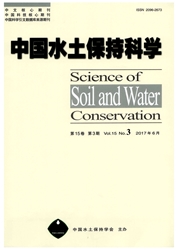

 中文摘要:
中文摘要:
土壤分离能力是土壤侵蚀机理模型的重要参数。受土壤性质、植被根系等因素影响,土壤分离能力呈现显著的季节变化。为研究草地土壤分离能力季节变化特征及其影响机制,以建植一年的柳枝稷、无芒雀麦草地及对照裸地为研究对象,以20 d为周期,测定土壤密度、黏结力和根系密度,并采集原状土样进行水槽实验(τ=6.5-23.4Pa),测量土壤分离能力,并运用相关分析、回归分析等方法,研究土壤性质及植被根系对土壤分离能力季节变化的影响。结果显示:柳枝稷和无芒雀麦草地具有类似的季节变化特征,而裸地与二者差异明显。4月中旬至6月下旬,草地土壤分离能力较大,此后土壤分离能力迅速下降;7月中旬直至10月上旬,草地土壤分离能力较低;10月下旬,土壤分离能力小幅回升;裸地土壤分离能力7、8月份较低,其余时间较高。裸地土壤分离能力试验期均值为柳枝稷草地的10.6倍,无芒雀麦草地的23.7倍。草地土壤分离能力的季节变化受根系密度和土壤黏结力的影响,随着根系密度与土壤黏结力增大,土壤分离能力呈指数形式降低,而土壤密度对土壤分离能力季节变化的影响并不显著。试验区内草地土壤分离能力可用水流剪切力、根系密度、根径和土壤黏结力等参数进行模拟(R2=0.636)。研究结果可为土壤侵蚀机理模型的推广应用,以及小流域水土保持措施配置等工作提供科学依据。
 英文摘要:
英文摘要:
[Background] Soil detachment capacity by concentrated flow is an important parameter in many physically-based soil erosion models. The seasonal variations in soil detachment capacity and its influencing factors are crucial for accurate prediction of soil loss but not fully quantified in grasslands[Methods] This study was conducted to investigate the seasonal variation and quantify the potential factors causing changes in soil detachment capacity. The temporal variations in soil detachment capacity for two grasslands and one bare soil were monitored at 20-day intervals from April to October 2011.Undisturbed topsoil samples were taken and subjected to 6 different flow shear stresses( τ = 6. 5- 23. 4Pa) in a laboratory flume with the fixed bed to measure soil detachment capacity by concentrated flow.Soil bulk density,soil cohesion,and root mass density were measured at the time of sampling to revealthe observed variations in soil detachment capacity. [Results] Distinctive seasonal variation patterns were found throughout the growing season. The seasonal variability in soil detachment capacity under grasslands differed significantly from that of bare soil. Soil detachment capacity in grasslands was relatively high from mid-April to last-June,then declined quickly with grass growth,and maintained at a very low level from mid-July to early-October. In the end of growing season,soil detachment capacity in grasslands increased slightly. For the bare soil,soil detachment capacity was relatively high in the midApril and declined gradually in May,June,and July. It reached the minimum at early-August,then increased again and continued to the end of the measurement period. The mean soil detachment capacity of bare soil was 10. 6 and 23. 7 times greater than of switchgrass( Panicum virgatum) and smooth bromegrass( Bromus inermis Leyss) soils,implying that the bare soil was much more erodible than grasslands. Seasonal variation in soil detachment capacity of grasslands could be mainly explained by variations in soi
 同期刊论文项目
同期刊论文项目
 同项目期刊论文
同项目期刊论文
 期刊信息
期刊信息
